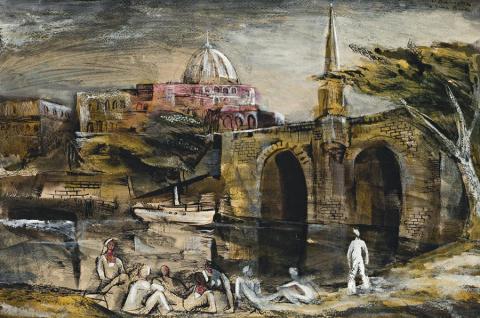THE YARRA BANKS, 1946
Donald Friend
watercolour, ink and gouache on paper on composition board
37.0 x 55.5 cm
signed, dated and inscribed upper right: Donald, ‘46 / The Yarra Banks
Collection of Madame Cécile Chanel, Paris
Private collection, Paris
Such was the promise shown by Donald Friend in the 1940s that Robert Hughes, in his later monograph on the artist, included him among 'the three capital D's of the forties in Sydney- Drysdale, Dobell, Donald -'.1 His brilliance as a draughtsman singled him out as one of the bright young hopes of Australian art. The fluency of his line achieved unrivalled heights in his drawings of the male nude, and gave a special vivacity to his subject pictures. In The Yarra River 1945 promise morphs into achievement, the romantically presented view delineated with a lively and evocative line of pen and ink. Elegant colours, white highlights and seductive forms add to its undeniable charm in the creation of this Melbourne capriccio.
In February 1945 Friend was offered a commission as an official war artist. Travelling to Melbourne to complete the formalities, he was given the rank of Lieutenant attached to the RAAF. At this time seven of Friend's paintings were included in The Herald Exhibition of Australian Present-day Art: From New South Wales and Other States , shown in the Melbourne Lower Town Hall. They were warmly praised by George Bell, 'Donald Friend has perhaps the most lively aesthetic imagination and to look at his pictures is an adventure.'2 Returning to Sydney in April and then on to Morotai in May, the time Friend spent in Melbourne was very short. As a result his Melbourne works of this time are particularly rare. Two - Latrobe House, Melbourne and Boat House on the Yarra were shown in his Exhibition of Drawings at the Macquarie Galleries, Sydney in April 1945. In addition there are his 'war' pictures such as Young & Jackson's Corner in the collection of the Australian War Memorial, Canberra. Having completed his work as an official war artist, Friend was discharged at the end of March 1946, his most important painting for that year being The Apotheosis of Ned Kelly commissioned by Mrs R. M. Instone of Sydney.
During 1944 Friend completed a number of pen and ink drawings, worked with wash and gouache. Of these, The Incinerator was purchased by his friend Russell Drysdale, who described it as 'so grand'.3 Now in the collection of the Art Gallery of New South Wales, it joins another related work, Brisbane River 1944, which has subject and compositional affinities with The Yarra River 1945. While our drawing shows spectacular advances over those of 1944, the Melbourne work similarly reflects bridge and city buildings in the still, foreground waters. Friend responded with creative invention to the Melbourne icons of the Flinders Street Railway Station and its grand dome, the spire of St Paul's Cathedral, and Princes Bridge across the Yarra River. The foreground group of relaxed American sailors refers to the time he spent there towards the end of the war. When enjoying a work such as this, it is easy to understand John Olsen's remark - 'Donald Friend has dazzled the stage of Australian art for well over a decade.'4
1. Hughes, R., Donald Friend, Edwards & Shaw, Sydney 1965, p. 12
2. Quoted in Pearce, B., Donald Friend, 1915 -1989 Retrospective, Art Gallery of New South Wales, Sydney, 1990, p. 146
3. Russell Drysdale quoted in Pearce, ibid., p. 48
4. Olsen, J., 'Foreword', Hughes, op. cit., p. 6
DAVID THOMAS
